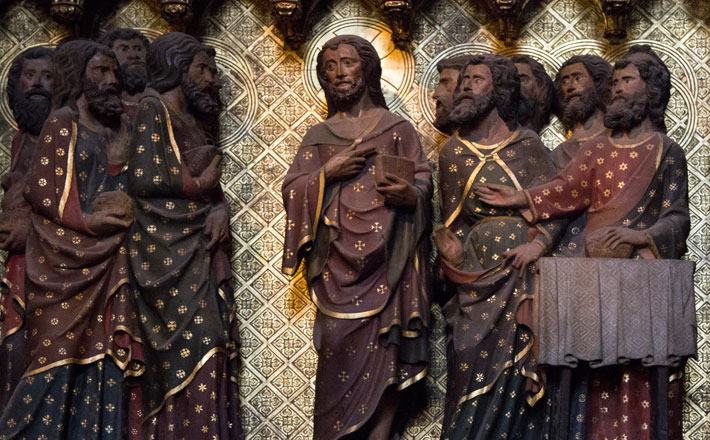Commentary on Luke 24:36b-48
Have you ever read the book All I Really Need to Know I Learned in Kindergarten by Robert Fulghum?
Even though the title is hyperbolic it points incisively to core ways of being with others in the world. If you can share, refrain from hitting, clean up after yourself, apologize when you hurt someone, etc. you will be well on your way to becoming a kind and productive citizen.
How would you respond if I told you that everything you need to know about Jesus Christ is found in Luke 24:36b-48? Though equally hyperbolic to Fulghum’s classic book, this pericope functions as a sort of précis of Jesus’ life and ministry. It is also catechetical, pointing to key doctrinal truths about Jesus with which the early church struggled. Let’s take a closer look.
- Jesus brings peace to the anxious.
This text flows directly from the Road to Emmaus narrative (Luke 24:13-35). In today’s Scripture lesson, Jesus appears to a group of people that we know to be the eleven disciples and their companions (cf. Luke 24:33), which include the two unnamed Jesus-followers who had journeyed from Jerusalem to Emmaus, and in all likelihood Mary Magdalene, Joanna, Mary the mother of James, and a coterie of other women. So far, news of Jesus has been nebulous: two men in dazzling clothes appear to the women proclaiming resurrection (Luke 24:4-7); Jesus himself appears though he is unrecognizable (Luke 24:16). Anxiety was high. Jesus’ first words to his followers were “peace to you.” Jesus inaugurates a peace that arises out of — and sometimes in the absence of — faith.
- Jesus’ presence ought to haunt every fellowship worthy of his name.
When Jesus appears to his followers, they think they are seeing a ghost (Luke 24:37). They are “terrified” and “filled with fear.” This is completely understandable: dead stuff is supposed to stay dead! And yet here Jesus is, resurrected. In another sense, Jesus’ resurrection means that what he said was true, and if he was not bluffing about his resurrection we need to assume that Jesus really meant what he said about how his followers are to treat others, especially the marginalized.
- God really resurrected Jesus from the dead.
Jesus’ bodily appearance, and the narratological lengths Luke takes to assert this fact, makes all Gnostic and Docetic beliefs untenable. The resurrected Christ was no disembodied spirit. Nor was Jesus merely a resuscitated corpse. Jesus is not a ghost; he is a real person. The resurrected Christ has a body, and even if contemporary believers cannot embrace Jesus as his disciples did, we bear witness to more than a spiritualized, demythologized Christ when we preach about Jesus’ resurrection.
- Even as the resurrected Christ, Jesus continues to bear the marks of his suffering for us.
Even resurrected, Jesus’ body bears witness to a way of being for others. He embodies love. As Fred Craddock observes,
This identification [between Jesus and eternal Christ] is critical, not just for theology but also for defining the nature of Christian life. If the Jesus who died belongs to the historical past but the one disciples now follow is the eternal Christ, then the Christian life can take on forms of spirituality that are without suffering for others, without a cross, without any engagement of issues of life in this world, all the while expressing devotion to a living, spiritual Christ.1
Jesus says, “Look at my hands and my feet; see that it is I myself.” His pierced body bears witness against a mode of discipleship that does not endure scars on behalf of others.
- We cannot understand the Scriptures apart from Jesus’ life, ministry, and resurrection.
The criterion by which the Bible is to be interpreted is Jesus Christ. As Luke Timothy Johnson avers, “It is the risen Lord who teaches the Church to read Torah properly.”2 It is impossible for Christ-followers to understand the Hebrew Scriptures apart from Jesus’ life, ministry, crucifixion, and resurrection. This does not mean that Christians have a monopoly of biblical hermeneutics, but that a properly Christian hermeneutic demands a Christocentric horizon of interpretation.
- Jesus commissions us to bear witness to his life, ministry, and resurrection.
What then shall we do? Jesus tells us. Christ followers are to proclaim “repentance and forgiveness of sins” and to serve as “witnesses” to the life, ministry, crucifixion, and resurrection of Jesus vis-à-vis the Scriptures (Luke 24:46-48). Inasmuch as we participate in the revelation of God in Jesus Christ through our reading of Luke’s Gospel, we too are witnesses to what God has done for us in Christ. It’s not fancy, nor is it complicated. We are to tell the story of Jesus, which leads to a change of mind (metanoia) and a proclamation that in Christ we find forgiveness.
- The good news of Jesus Christ is good news for everybody.
Luke’s Jesus is clear on the fact that “repentance and forgiveness of sins is to be proclaimed in his name to all nations, beginning from Jerusalem.” This is the narratological hinge that connects the Gospel of Luke and the Acts of the Apostles. We must remember that the good news of Jesus Christ follows a centrifugal trajectory. It is universal in its scope and particular in its articulation. The Church today must remember that the blessings of God in Jesus Christ transcend racial, ethnic, gendered, and heteronormative prejudices. It is good news for everyone without exception.
In today’s lection, we find the good news of God revealed in Jesus Christ laid out in miniature. It offers the contemporary preacher an angle of vision on the essence of Jesus’ life and ministry and as such it provides an opportunity for catechetical proclamation that arises out of a discrete pericope.
Notes:
1 Fred Craddock, Luke. Interpretation (Louisville: John Knox Press, 1990), 290.
2 Luke Timothy Johnson, The Gospel of Luke. Vol. 3. Sacra Pagina (Collegeville, MN: The Liturgical Press, 1991), 405.


April 19, 2015